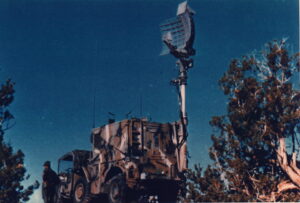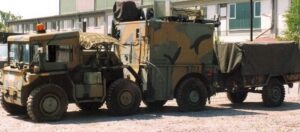Disclaimer
The FAAR16J.Com website-based platform was designed as a fandom website providing information resources as well as a link connection to with the goal of honoring the U.S. Army Air Defense Soldiers who operated the FAAR Forward Area Alerting Radar Operators Facebook group page and is not affiliated with the group
AN/MPQ-49 Forward Area Alerting Radar (FAAR)

Description:
The AN/MPQ-49 Forward Area Alerting Radar (FAAR) is a mobile, ground-based radar system developed by the United States Army for air defense purposes. It was designed to provide early warning of low-flying aircraft and helicopters to forward-area troops, thereby enhancing their ability to respond to aerial threats. The system features a lightweight, transportable radar mounted on a trailer, which can be easily deployed and set up in various terrain conditions.

Key Features:
Mobility: Mounted on a trailer for easy transportation and quick deployment.
Detection Capabilities: Capable of detecting low-flying aircraft and helicopters.
Early Warning: Provides early warning to forward-area units, allowing for timely defensive actions.
Integration: Can be integrated with other air defense systems for a comprehensive air defense network.
Development
FAAR was developed by the US Army in the 1960s to support their field anti-aircraft weapons, the M48 Chaparral and M163 Vulcan Air Defense System, deployed through the 1970s and 80’s, and retired from active service in 1991. FAAR units have been used for drug trafficking surveillance in Palm Beach, and since September 1991, offered for sale to foreign users.
The AN/TPQ-43 radar was mounted on a boom that extended upward from the rear of the Gama Goat’s trailer. It is a pulse doppler radar that operates in the D band and has a range of about 20 km. Data from the radar was generally not used at the radar site itself, but broadcast over FM radio to the “Target Alerting Data Display Set” (TADDS), a small battery-powered receiver and display unit.[2] Field units, including the Chaparral, Vulcan and FIM-43 Redeye units, used the TADDS as an early-warning display, aiming their optically-guided weapons in the general direction it provided.
FAAR was transported by a Gama Goat and set up behind the front lines. The generator is towed behind the Gama Goat’s own trailer, and then detached and operated at a distance from the trailer. The entire system is easily air-transportable
Mission:
The primary mission of the FAAR was to provide forward-deployed troops with an early warning system against low-flying aircraft, enhancing their situational awareness and defensive capabilities. This was particularly critical during the Cold War era, where the threat of sudden air attacks was a significant concern for forward-deployed units.
History:
Development: The FAAR was developed during the Cold War, a period marked by heightened tensions and the need for advanced air defense systems to protect ground forces.
Deployment: It was deployed to various forward areas where the threat of low-altitude air attacks was significant. The mobility of the system allowed it to be used in a variety of environments, from Europe to other potential conflict zones.
Operational Use: Throughout its service life, the FAAR was used in various training exercises and operational deployments, contributing to the overall air defense strategy of the U.S. Army.
Obsolescence: With advancements in radar technology and the development of more sophisticated air defense systems, the FAAR eventually became obsolete. It has since been replaced by more modern systems that offer enhanced detection capabilities and integration with contemporary air defense networks.
Significance:
The FAAR played a crucial role in the air defense strategy of the U.S. Army during its time in service. By providing early warning of low-flying threats, it helped to protect forward-deployed troops and maintain air superiority in critical areas. The system’s mobility and ease of deployment made it a versatile asset in various operational contexts.
Conclusion
The AN/MPQ-49 Forward Area Alerting Radar (FAAR) was an important component of the U.S. Army’s air defense arsenal during its operational period. Its ability to provide early warning of low-flying aircraft and helicopters significantly enhanced the defensive capabilities of forward-deployed troops, making it a valuable asset in the Cold War era and beyond.
The information provided about the AN/MPQ-49 Forward Area Alerting Radar (FAAR) is based on general knowledge of military radar systems and their historical context. Here are some common sources that might contain relevant information on such systems:
- Military Equipment Manuals and Technical Documents:
- Official technical manuals and field manuals produced by the U.S. Army.
- Manufacturer’s brochures and technical specifications.
- Historical Military Records:
- S. Army historical archives and records.
- Reports and documentation from the U.S. Army Center of Military History.
- Books and Articles on Military Technology:
- Books on Cold War military technology and air defense systems.
- Articles in military journals and defense technology magazines.
- Government and Defense Websites:
- S. Army websites and defense-related government sites.
- Online databases such as the Defense Technical Information Center (DTIC).
- Academic and Research Institutions:
- Research papers and theses from military academies and defense studies programs.
- Online Databases and Resources:
- Jane’s Defence Equipment and Technology.
- org.
- Federation of American Scientists (FAS) Military Analysis Network.
- Wikipedia – https://en.wikipedia.org/wiki/AN/MPQ-49_Forward_Area_Alerting_Radar
For more specific sources or detailed documents, we recommend accessing these types of resources or visiting libraries and archives that specialize in military history and technology.


